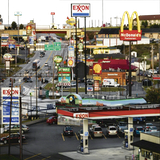it’s bad folks
American cities look great from a few thousand feet up in the air, if you focus the shot on a giant park where nobody lives, works, or sells shit.
of course, I could find a close up shot in any American city that would require anyone looking at it to get a tetanus shot and take two Silkwood style showers.
Conversely you can also find pictures of “Third world” cities that look wonderful, clean, and modern. Compare the Vietnamese newly built Ho Chi Minh metro system with some downtown Manhattan metro stations, and it’s not Manhattan that comes out looking nice. You have to compare like for like. The average downtown business district of pretty much any decently sized city on earth, “Third world” or otherwise, is going to look nice and clean from afar.
Mogadishu, Somalia

Bakuva, DRC

Dar Es Salaam, Tanzania

3 of the poorest cities on the planet, brought to you by the power of selective photography!
This is all true but…
You have to compare like for like.
In order to avoid creating false equivalences, you have to compare representative samples.
The average American does not live in a shiny NY apartment and commute by metro, but the average resident of Vietnam isn’t living in Ho Chi Minh City either.
Well that’s my point, you have to compare like to like. Ho Chi Minh is the economic centre of Vietnam and a major city, as is NYC for the United States, so it’s a completely appropriate comparison. Comparing NYC’s newly built Moynihan Station to random dilapidated rural train station in Vietnam is just as disingenuous as comparing the sleek modern airport of Hanoi to a tiny run down airport in West Virginia.
But, worded that way, your point is going to get you into difficulty if you try making that argument with a liberal who fancies themself trained to handle data, and I’d prefer it if you weren’t caught off guard like that. You might still waste time clarifying with me, but at least I’m on your side.
Yes, comparing good thing of group 1 to bad thing of group 2 is as disingenuous as comparing bad thing of group 1 to good thing of group 2.
But comparing atypical good thing of group 1 to atypical good thing of group 2 is also fraught with problems, even though—and especially because—it looks like it’s legitimate, since it can be described as a like-for-like comparison. This is, for example, how Dubai tries to gloss over its problems: by playing up the fact that it’s a modern city just like any other.
The flaw of Art Candee’s comparison isn’t that it’s disingenuous, even though the point (jingoistic supremacy) being made with the flawed comparison certainly is. As far as the comparison goes, the real problem is only that the samples aren’t representative.
And comparing modern things enjoyed by a minority in two different places is also unrepresentative. It’s very much a false equivalence, every bit as much as comparing terrible things suffered by the worst off in two different places.
To stick with the specific example of Vietnam and the US, these two places really do have genuine differences, as comparisons of representative samples will demonstrate. To compare them on a like-for-like basis, you have to pick and choose your samples and, in doing so, you introduce selection bias, undermining the validity of the comparison. It suggests a sameness that obscures the broader reality.
It’s not that you can’t, or shouldn’t, point out the successes of various groups in their defence. I agree that doing so is important to counter the opposing narratives. But when you do, you shouldn’t call them “completely appropriate” “like for like” comparisons because, statistically speaking, they aren’t appropriate at all.
TL; DR
When out in the wild, avoid defending your counter-comparisons as “like for like”. Instead describe them as highlighting the selection bias of the original claim. You’ll keep a couple of gotcha libs at bay that way.
“our three largest cities, and a third world country.”
Oh ok, what do these look like?
Edited marketing photo of a private college campus in Chicago.
Edited marketing photo of Central Park in NYC.
Edited marketing photo of a multibillion dollar private subdivision near LA.
Bitcrushed photo of an apartment building mere moments after being hit by a hurricane.

Cities around the world, in the richest provinces and counties of a nation typically look good from up high like this. You can easily reverse this by taking drone shots of tier 1 Chinese cities and juxtapose it with photos of Manhattan at street level.
Show Houston and then tell me that American cities have anything going for them.


The power of angles
Not really, that place still looks miserable and it’s a wonderul counterexample if I was writing a chapter on land use for an urbanism textbook.
And it looks even worse from ground level. Looks like the Exxon station is gone. How the fuck does a gas station close in the US?

This is Breezewood, PA, for anyone who wants to see for themselves: an absolute asphalt-ridden hellscape of which tens of thousands are strewn about this godforsaken country.
it still looks like shit
dude texas sucks. it’s nice that you haven’t cut down all your trees or something? but it still sucks
Not Texas, but Pennsylvania. Your point still stands though.

I’ve seen the Chinese tourism sizzle reels on RedNote. I cant unsee them
Switzerland and China have some of the most picturesque tourism videos. Whoever is pushing those out better be getting PAID.
deleted by creator
So the difference between a third world and a first world country is that the first world country can afford to take aerial shots of its cities?
I challenge her to define what a “third world country” is. Traditionally it was countries unaligned to the West/USA or Russia. Mexico would be a 3rd world country.
Perhaps she means “developing country”?
she forgot the honkie shitting streets of frisco













